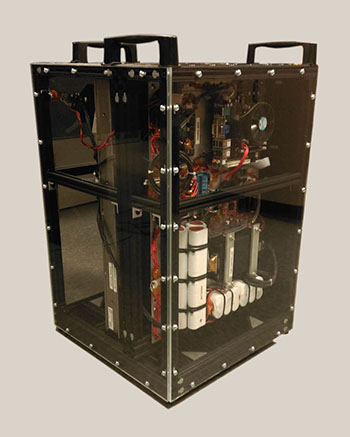SwRI scientists develop solar observatory for use on suborbital manned space missions

Image Courtesy of Southwest Research Institute The SwRI Solar Instrument Pointing Platform (SSIPP).
Using reusable suborbital commercial spacecraft for the SSIPP development effort improves on a traditional space instrument development process that goes back to the dawn of the space age, according to principal investigator Dr. Craig DeForest, a principal scientist in SwRI’s Space Science and Engineering Division.
“Development and testing of space instrumentation has been essentially unchanged since World War II: New instruments were mated to sounding rockets, which are hand-built, miniature spacecraft that fly five-minute missions but require months, and sometimes years, between flights because the payloads typically need reconditioning after each flight.
“Commercial manned flights have the potential to completely change all that by providing a stabilized, completely reusable platform that is 30 times less expensive per flight than sounding rockets and can fly many times per week,” DeForest said. “SSIPP is a first step to exploiting that platform. We hope to enable space-based observation in the same, inexpensive mode as ground-based observatories, where a scientist might build up a new instrument for a single observation and break it down a week later.”
SSIPP uses a classic, two-stage pointing system similar to larger spacecraft, but in this case the first stage is a pilot who initially steers the instrument toward the Sun, explained Systems Engineer Jed Diller, also of SwRI. “SSIPP does the rest, locking onto the Sun to allow observations,” he said.
The first SSIPP space flight will search for “solar ultrasound,” which DeForest said is a phenomenon first observed in the early 2000s by the Transitional Region and Coronal Explorer (TRACE) spacecraft. The “ultrasound” is sound waves with 10 second period, some 18 octaves deeper than ultrasound on Earth, and forms visible ripples in the Sun’s surface layers. The waves are difficult to detect without space instrumentation, because the tiny, rapid fluctuations cannot be separated from the confounding influence of Earth’s turbulent atmosphere, he said.
The first test flights of SSIPP will be aboard a general aviation aircraft during the spring of 2015. It is scheduled to fly on XCOR’s Lynx suborbital spacecraft immediately on completion of XCOR’s flight test program in 2015.
Although at first SSIPP will be operated from inside the cockpit, a full system eventually will be mounted outside the host vehicle to enable ultraviolet (UV) and X-ray observations that are inaccessible from the ground.
SSIPP will be on display at the XCOR booth, No. 2723.
For more information, contact Joe Fohn, (210) 522-4630, Communications Department, Southwest Research Institute, PO Drawer 28510, San Antonio, TX 78228-0510
Media Contact
More Information:
http://www.swri.org/9what/releases/2014/ssipp.htm#.VIr3e2EwfcsAll latest news from the category: Physics and Astronomy
This area deals with the fundamental laws and building blocks of nature and how they interact, the properties and the behavior of matter, and research into space and time and their structures.
innovations-report provides in-depth reports and articles on subjects such as astrophysics, laser technologies, nuclear, quantum, particle and solid-state physics, nanotechnologies, planetary research and findings (Mars, Venus) and developments related to the Hubble Telescope.
Newest articles

Properties of new materials for microchips
… can now be measured well. Reseachers of Delft University of Technology demonstrated measuring performance properties of ultrathin silicon membranes. Making ever smaller and more powerful chips requires new ultrathin…

Floating solar’s potential
… to support sustainable development by addressing climate, water, and energy goals holistically. A new study published this week in Nature Energy raises the potential for floating solar photovoltaics (FPV)…

Skyrmions move at record speeds
… a step towards the computing of the future. An international research team led by scientists from the CNRS1 has discovered that the magnetic nanobubbles2 known as skyrmions can be…





















